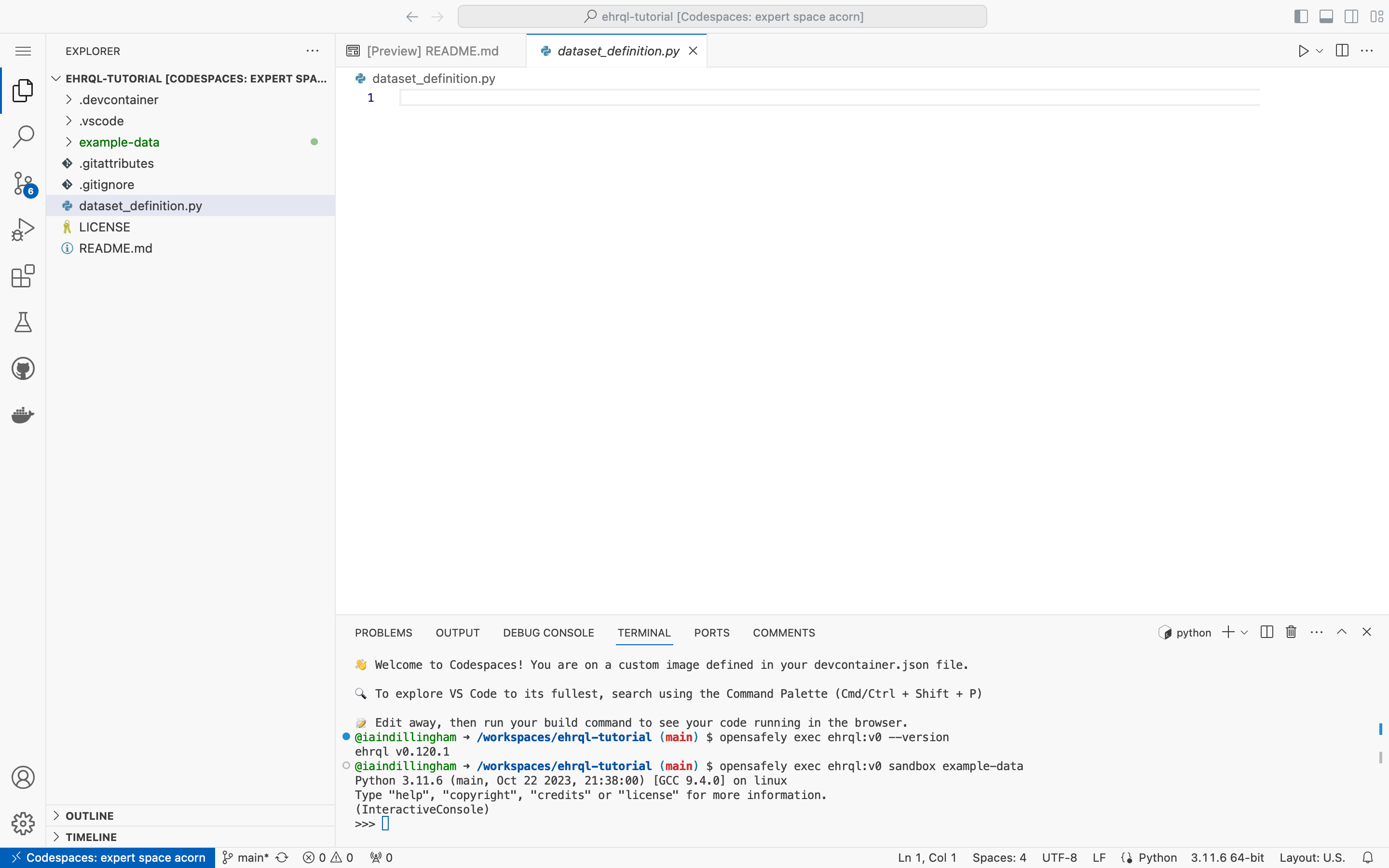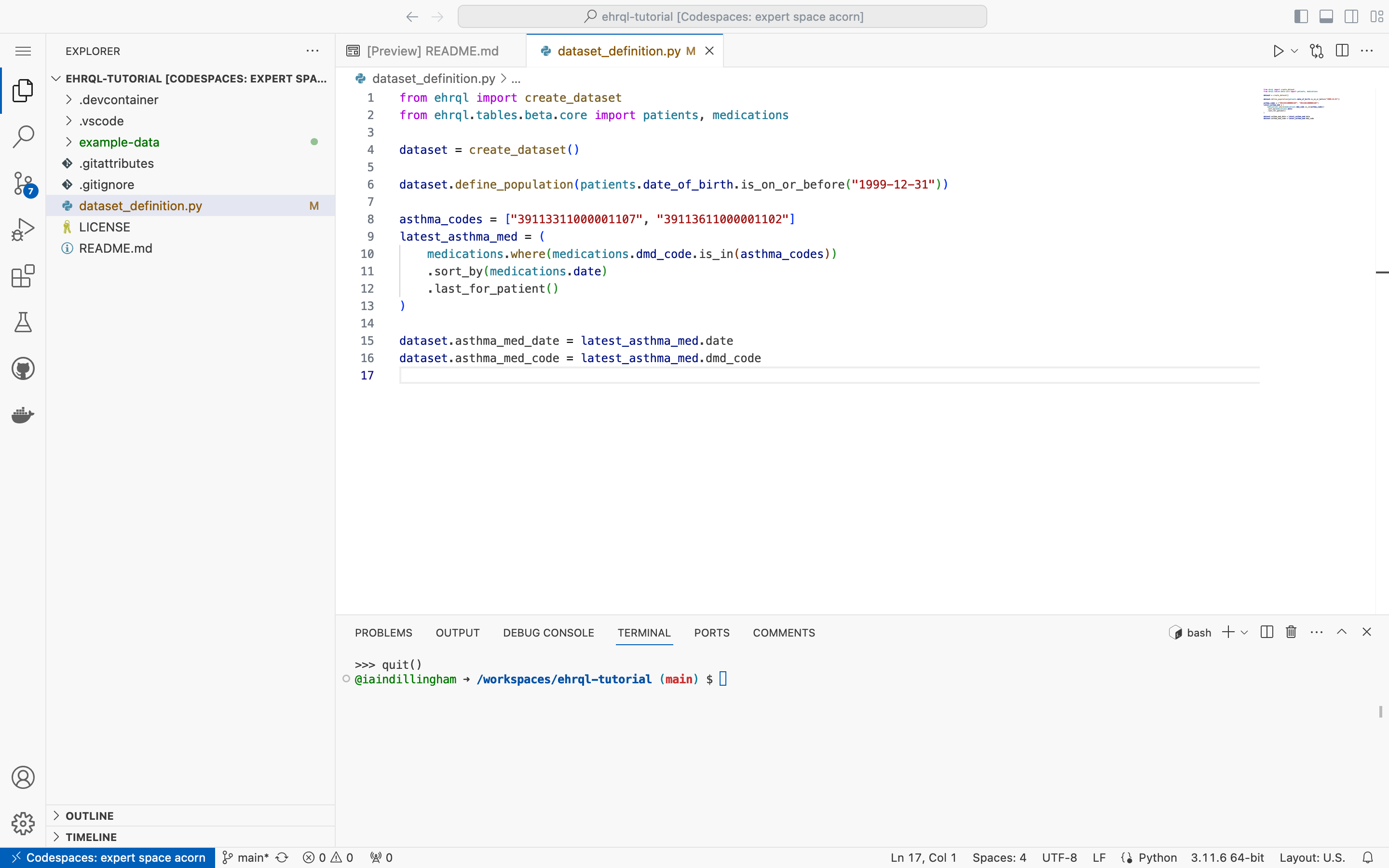Writing a dataset definition
In this section, you will write the following dataset definition. It selects the date and the code of each patient's most recent asthma medication, for all patients born on or before 31 December 1999.
from ehrql import create_dataset
from ehrql.tables.core import patients, medications
dataset = create_dataset()
dataset.define_population(patients.date_of_birth.is_on_or_before("1999-12-31"))
asthma_codes = ["39113311000001107", "39113611000001102"]
latest_asthma_med = (
medications.where(medications.dmd_code.is_in(asthma_codes))
.sort_by(medications.date)
.last_for_patient()
)
dataset.asthma_med_date = latest_asthma_med.date
dataset.asthma_med_code = latest_asthma_med.dmd_code
Importing tables
The tables are imported from the ehrql.tables.core schema in the above dataset definition.
Consequently, it can be run on any backend.
If you need a table that's only available in one backend,
then you should import the table from a non-core schema,
such as ehrql.tables.tpp or ehrql.tables.emis.
Open the dataset definition🔗
- Click
dataset_definition.pyin the Explorer towards the top left of the codespace

For the remainder of this section,
you should type the code into dataset_definition.py.
Interact with the code in the sandbox
As well as typing the code into dataset_definition.py,
you can interact with the code in the sandbox.
Remember, when you see >>>,
you should type the code that follows into the sandbox and press Enter.
Import the create_dataset function🔗
from ehrql import create_dataset
Import the create_dataset function into the sandbox
Importing a function into the sandbox doesn't display any output.
>>> from ehrql import create_dataset
Import the tables🔗
The patients table has one row per patient.
The medications table has many rows per patient.
from ehrql.tables.core import patients, medications
Import the tables into the sandbox
Importing tables into the sandbox doesn't display any output.
>>> from ehrql.tables.core import patients, medications
Create the dataset🔗
dataset = create_dataset()
Create the dataset in the sandbox
Creating the empty dataset doesn't display any output.
>>> dataset = create_dataset()
>>> dataset
Dataset()
Define the population🔗
Define the population as all patients born on or before 31 December 1999.
dataset.define_population(patients.date_of_birth.is_on_or_before("1999-12-31"))
Breaking down defining the population in the sandbox
.define_population takes a population condition in the form of a boolean column.
However, patients.date_of_birth is a date column.
>>> patients.date_of_birth
1 | 1973-07-01
2 | 1948-03-01
3 | 2003-04-01
4 | 2007-06-01
5 | 1938-10-01
6 | 1994-04-01
7 | 1953-05-01
8 | 1992-08-01
9 | 1931-10-01
10 | 1979-04-01
To transform a date column into a boolean column,
use .is_on_or_before with a date.
>>> patients.date_of_birth.is_on_or_before("1999-12-31")
1 | True
2 | True
3 | False
4 | False
5 | True
6 | True
7 | True
8 | True
9 | True
10 | True
Compare the patients in the boolean column with the patients in the dataset, after defining the population.
>>> dataset.define_population(patients.date_of_birth.is_on_or_before("1999-12-31"))
>>> dataset
patient_id
-----------------
1
2
5
6
7
8
9
10
Notice that patients with True in the boolean column are included in the population;
and patients with False in the boolean column are excluded from the population.
Select each patient's most recent asthma medication🔗
Define a list of asthma codes.
Filter the medications table,
so that it contains rows that match the asthma codes on the list.
Sort the resulting table by date,
so that the most recent asthma medication is the last row for each patient.
From the resulting table,
select the last row for each patient.
The result is a table that contains each patient's most recent asthma medication.
asthma_codes = ["39113311000001107", "39113611000001102"]
latest_asthma_med = (
medications.where(medications.dmd_code.is_in(asthma_codes))
.sort_by(medications.date)
.last_for_patient()
)
Unpack the filter, the sort, and the select in the sandbox
Define a list of asthma codes.
>>> asthma_codes = ["39113311000001107", "39113611000001102"]
medications.dmd_code is a code column.
>>> medications.dmd_code
1 | 1 | 39113611000001102
2 | 2 | 39113611000001102
2 | 3 | 39113311000001107
2 | 4 | 22777311000001105
4 | 5 | 22777311000001105
5 | 6 | 39113611000001102
6 | 7 | 3484711000001105
6 | 8 | 39113611000001102
8 | 9 | 3484711000001105
10 | 10 | 3484711000001105
Create a filter condition in the form of a boolean column.
>>> medications.dmd_code.is_in(asthma_codes)
1 | 1 | True
2 | 2 | True
2 | 3 | True
2 | 4 | False
4 | 5 | False
5 | 6 | True
6 | 7 | False
6 | 8 | True
8 | 9 | False
10 | 10 | False
Filter the medications table,
so that it contains rows that match the asthma codes on the list.
>>> medications.where(medications.dmd_code.is_in(asthma_codes))
patient_id | row_id | date | dmd_code
------------------+-------------------+-------------------+------------------
1 | 1 | 2014-01-11 | 39113611000001102
2 | 2 | 2015-08-06 | 39113611000001102
2 | 3 | 2018-09-21 | 39113311000001107
5 | 6 | 2017-05-11 | 39113611000001102
6 | 8 | 2019-07-06 | 39113611000001102
Sort the resulting table by date, so that the most recent asthma medication is the last row for each patient.
>>> medications.where(medications.dmd_code.is_in(asthma_codes)).sort_by(medications.date)
patient_id | row_id | date | dmd_code
------------------+-------------------+-------------------+------------------
1 | 1 | 2014-01-11 | 39113611000001102
2 | 2 | 2015-08-06 | 39113611000001102
2 | 3 | 2018-09-21 | 39113311000001107
5 | 6 | 2017-05-11 | 39113611000001102
6 | 8 | 2019-07-06 | 39113611000001102
From the resulting table, select the last row for each patient.
>>> medications.where(medications.dmd_code.is_in(asthma_codes)).sort_by(medications.date).last_for_patient()
patient_id | date | dmd_code
------------------+-------------------+------------------
1 | 2014-01-11 | 39113611000001102
2 | 2018-09-21 | 39113311000001107
5 | 2017-05-11 | 39113611000001102
6 | 2019-07-06 | 39113611000001102
Add the date column to the dataset🔗
Select the date column and add it to the dataset.
dataset.asthma_med_date = latest_asthma_med.date
Add the date column to the dataset in the sandbox
>>> dataset.asthma_med_date = latest_asthma_med.date
>>> dataset
patient_id | asthma_med_date
------------------+------------------
1 | 2014-01-11
2 | 2018-09-21
5 | 2017-05-11
6 | 2019-07-06
7 | None
8 | None
9 | None
10 | None
Add the code column to the dataset🔗
Select the code column and add it to the dataset.
dataset.asthma_med_code = latest_asthma_med.dmd_code
Add the code column to the dataset in the sandbox
>>> dataset.asthma_med_code = latest_asthma_med.dmd_code
>>> dataset
patient_id | asthma_med_date | asthma_med_code
------------------+-------------------+------------------
1 | 2014-01-11 | 39113611000001102
2 | 2018-09-21 | 39113311000001107
5 | 2017-05-11 | 39113611000001102
6 | 2019-07-06 | 39113611000001102
7 | None | None
8 | None | None
9 | None | None
10 | None | None
Save the dataset definition🔗
-
Click the menu icon towards the top left of the codespace

-
Click File > Save
Exit the sandbox🔗
Exit the sandbox and return to the terminal.
>>> quit()
